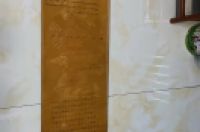
圣旨 ,是指古代中国社会时皇帝下的命令或发表的言论。今常用于比喻,假传圣旨。
圣旨是中国古代帝王权力的展示和象征,其轴柄质地按官员品级不同,严格区别:一品为玉轴,二品为黑犀牛角轴,三品为贴金轴,四品和五品为黑牛角轴。 圣旨的材料十分考究,均为上好蚕丝制成的绫锦织品,图案多为祥云瑞鹤,富丽堂皇。
圣旨两端则有翻飞的银色巨龙作为防伪标志。作为历代帝王下达的文书命令及封赠有功官员或赐给爵位名号颁发的诰命或敕命,圣旨颜色越丰富,说明接受封赠的官员官衔越高。
圣旨
“受命于天,天意之所予也,故号为天子者,亦视天如父,事天以孝道也”《春秋繁露·深察名号》。这是“奉天”的来源。至于“承运”,又牵扯到邹衍的“五德始终说”。邹夫子认为五行相生相克,五行又配之五德,每一个朝代都代表其中一德,如黄帝尚土德、夏尚木德、殷尚金德、周尚火德。五德循环往复,朝代便兴亡绝续。奉天成运皇帝,诏曰翻译成现代汉语就是“奉上天之命而承世运之道的皇帝下诏书说”。钦此就是皇家专用名词,就是到这里结束的意思。一般古代圣旨分两种:圣旨开头是昭曰,是由皇帝口述旁人代写的;而开头为制曰,是由皇帝亲手所写的。
满文(满语:ᠮᠠᠨᠵᡠ ᡥᡝᡵᡤᡝᠨ,转写:manju hergen;英语:Manchu script)是用来拼写满语的文字。满文主要借鉴了传统的回鹘式蒙古文,后在此基础上加以改进,形成了符合满族本民族语言表达要求的新满文。
满族不仅创造了自己的文字——满文,而且将满文作为清朝的法定文字来推广和使用,形成了大量的满文古籍文献,包括图书、档案、碑刻、谱牒、舆图等等。在中国55个少数民族古籍文献中,无论是数量,还是种类,满文古籍文献都属于最多的一种。它在中国文字史的少数民族语言文字领域,有重要地位,是中华民族文化遗产的有机组成部分,具有重要的历史文化价值。
由于圣旨从拟稿到缮写均由顶尖文化高手来完成,因而这些圣旨在颇富史料价值的同时,更具有极大的艺术欣赏价值。其行文的精悍洗练,几乎达到了增一字嫌其累赘、减一字达意不确的程度。
清代圣旨均用汉文和满文合璧书写,汉文行款从右至左,满文行款从左至右,合于中幅书写日期,并钤盖“ 制诰之宝 ”。圣旨内容由翰林院撰拟,经内阁大学士奏定后再按品级填发。书写圣旨的任务,则是由皇帝从进士中亲自评点选拔出来的最优秀者“庶吉士”来承担的。
这卷圣旨开头为制曰,是由皇上本人亲自书写,比起普通的昭曰圣旨更为稀少难得,上有制诰之宝圣旨专用玉玺,圣旨氧化痕迹明显,其书写精美,极具书法价值,综合来看是一卷十分难得的馆藏级珍品,极具收藏价值。
英文翻译 :Imperial edict refers to the order or speech issued by the emperor in ancient Chinese society. It is often used as a metaphor.
Imperial decrees are the display and symbol of imperial power in ancient China. The texture of the shaft handle is strictly different according to the grade of officials: the first is the jade shaft, the second is the black rhinoceros horn shaft, the third is the gold shaft, and the fourth and fifth are the black ox horn shaft. Imperial edicts of the material is very elegant, are made of silk fabrics made of good silk, pattern for auspicious clouds cranes, magnificent.
At both ends of the imperial decree, there are silver dragons flying as anti-counterfeiting symbols. As the document orders issued by emperors of all dynasties and the mandate that enassigns the effective official or the mandate that enassigns the title title issues, mandate or rescript, the richer the imperial decree color is, the higher the official rank that explains accepts the enassigns.
Imperial edict
"Ordered by the day, God"s will to also, so the name for the son of heaven, also see the day as a father, the matter of the day to filial piety also" "Spring and Autumn Fandlu · Shencha name". This is the source of "Fengtian". As for "transport", Zou Yan is involved in the "five virtues always said". Master Zou believed that the five elements were mutually beneficial, and the five elements were matched with five virtues. Each dynasty represented one of these virtues, such as the Yellow Emperor Shangtu De, the Xia Shangmu De, the Yin Shangjin De, and the Zhou Shanghuo De. The cycle of the five virtues was repeated, and the dynasties rose and fell. Emperor Fengtian Cheng Yun, said that translated into modern Chinese is "the order of heaven and inherited the way of the emperor imperial edict said". This is a royal term, which means to end here. General ancient imperial edicts are divided into two kinds: the beginning of the edicts is Zhao Yue, is written by the emperor"s dictation of others; And the beginning for the day, is written by the emperor himself.
The manchu, manchu: ᠮ ᠠ ᠨ ᠵ ᡠ ᡥ ᡝ ᡵ ᡤ ᡝ ᠨ, transfer: manju hergen; English: Manchu Script is the script used to spell Manchu. The Manchu language mainly borrowed from the traditional Uighur Mongolian language, and then improved on this basis, forming a new Manchu language in line with the requirements of the native language expression of the Manchu people.
The Manchu people not only created their own language, Manchu, but also promoted and used Manchu as the official language of the Qing Dynasty, forming a large number of ancient Manchu documents, including books, archives, tablet inscriptions, charts, and so on. Among the 55 ancient books of ethnic minorities in China, the ancient books of Manchu are the most numerous in both quantity and type. It plays an important role in the field of minority languages in the history of Chinese writing. It is an organic part of the cultural heritage of the Chinese nation and has important historical and cultural value.
Since the edicts are all completed by top cultural experts from draft to scriptorium, these edicts not only have rich historical value, but also have great artistic appreciation value. His prose is concise and concise, almost to the extent that adding a word is too cumbersome and reducing a word is not accurate.
Imperial edicts of the Qing Dynasty were written in the combination of Chinese and Manchu. The Chinese style was written from right to left, and the Manchu style was written from left to right. The date was written in the middle piece, and the inscription "Treasure of Patent" was ringstamped. The CONTENT OF THE IMPERIAL DECREE IS PREPARED BY THE IMPERIAL ACADEMY, AND then issued according to the grade after the Cabinet Grand Bachelor has played. The task of writing imperial decrees was undertaken by the emperor, who personally selected the most excellent "Shujishi" from the Jin scholars.
This volume of imperial edict begins with the system, is written by the emperor himself, compared with the ordinary Zhao Yue imperial edict is more rare and rare, there is a special imperial seal of the imperial decree of patent, the oxidation trace of imperial decree is obvious, its writing is exquisite, very calligraphy value, in general, it is a very rare collection level treasures, very collection value.




